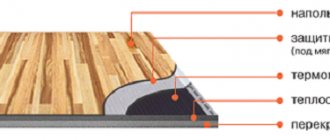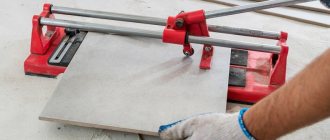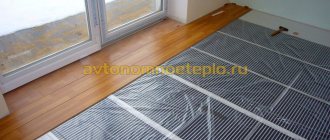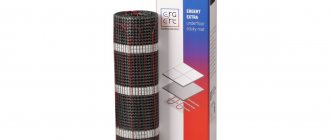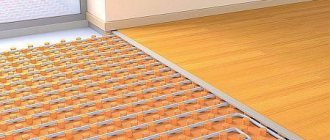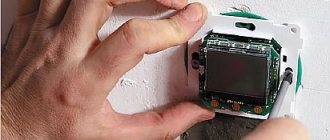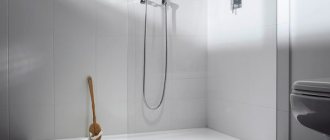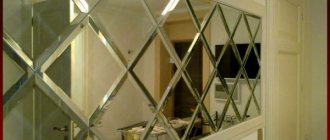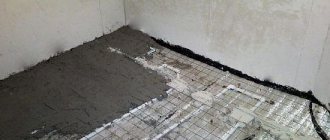An infrared film floor is a heating system carried out using a heating thin film with a conductive carbon layer (solid or arranged in stripes). The room is heated not through the screed, but thanks to infrared radiation, which heats surrounding objects (interior elements, walls, etc.), and is an excellent alternative to water and cable underfloor heating. Its advantage is ease and speed of installation.
The best covering for any heated floors, including film type, is considered to be tiles, especially when installing in the bathroom and kitchen (find out what type of flooring is best to choose for the kitchen and how to install it yourself). After all, tile is a durable material, durable, moisture-resistant and environmentally friendly.
Which floor is better to choose for tiles?
There are various models of heated floors, they are water and electric. The latter are divided into cable, rod and film. Each type has its pros and cons, which you should pay attention to when choosing flooring.
Water heated floors are a structure with a laid pipeline through which heated coolant circulates. Most often mounted in a screed.
Electric cable - the cable acts as a heating element. Like a water floor, this type is often filled with concrete screed, although the “dry” installation method is also acceptable.
Electric infrared floors are the easiest and most inexpensive type to install, especially in an apartment. It is a thin film with carbon plates.
Plus, when placed on a warm floor, tiles do not interfere with the passage of heat, which increases the efficiency of the heating system. The tiles are often placed on a concrete surface and fixed with glue. For water and cable floors filled with screed, this is an ideal finishing coating.
Decorative finishing of infrared heated floors with porcelain stoneware has a number of difficulties and features, since the “pie” is very thin. But in principle, there is no ban on such proximity.
Water heated floors
They are tubes with coolant placed under a thin screed and floor covering. Essentially, these are modified heating radiators. Therefore, this type of heating can be used both in combination with a traditional circuit, supplementing it, or independently, replacing it completely. The disadvantages of water heated floors include:
- A significant amount of screed, which not only reduces the height of the room, but also significantly increases the load on the floors.
- Possibility of leakage if the system's tightness is broken, which can lead to flooding of the neighbors below. And this can lead to very significant financial losses.
- In the event of a power outage or hot water in cold weather, the pipes of such a warm floor may defrost. The result is a large-scale system overhaul.
- Installation of water heated floors is quite complicated, so not everyone can do it themselves.
Is it possible to lay film flooring under tiles?
Before you decide to install an electric infrared film heated floor under PVC tiles, you should understand how to do it. Therefore, experts advise you to familiarize yourself with the installation rules of this system and the conditions of its operation.
The instructions for heated film floors indicate that different materials can be laid on them: linoleum, laminate, carpet. It is also permissible to place such a heating device under the tile. The description of the system contains recommendations on how to lay an infrared floor under the tiles.
For your information! Infrared heated floors can also be installed outdoors under porcelain stoneware, as they are not afraid of moisture.
When arranging paths near a house with this type of heating, they will never be covered with people.
Necessary materials
Standard equipment for a film heated floor system
The standard installation kit should include:
- Thermal film in a roll;
- Contact terminals;
- Set of wires;
- Bitumen insulation on a self-adhesive basis.
General view and main elements of thermal film
Additionally you will need to buy:
- Thermal reflective insulation;
- Heat-resistant polyethylene film;
- Thermostat and mounting box for it. It is selected based on the selected power of the heated floor and the type of installation (built-in or surface-mounted);
- Additional temperature sensor if necessary (one will be included with the thermostat);
- Double sided tape;
- Additional wire for mounting a thermostat. It may also be needed if you install several sets of heated floors in one room (you will need to add up their power to calculate the cross-section). The wire cross-section is selected depending on the power of the system and the material of the purchased wire (see table).
| Wire cross-section, mm2 | Maximum permissible power consumption with copper wire, kW | Maximum permissible power consumption with aluminum wire, kW |
| 1,5 | 3,5 | 2 |
| 2,5 | 5,5 | 3,5 |
| 4 | 7 | 5,5 |
| 6 | 9 | 7 |
Features of installing infrared floors under tiles
The only peculiarity when constructing such a “pie” with tiles is that not “dry” installation is used, but tile adhesive is used or a self-leveling floor is made.
If preference is given to the “wet” method, when constructing film floors, a number of features should be taken into account:
- Low adhesion - in this regard, simply filling such floors with cement mortar is not recommended, since the structure will be floating. If something heavy falls on such a surface, the screed may crack, and it will be difficult to eliminate these defects.
Some try to increase adhesion by applying notches to the product, but experts do not advise resorting to this method. These places are difficult to insulate, which can lead to current leakage.
- The film does not tolerate alkali well - the alkali contained in the cement mortar will have a negative effect on IR floors. This will lead to their rapid failure.
If you nevertheless decide to install a heated film floor under the tiles with your own hands, then during the installation process you should adhere to certain technological conditions, which are described in detail below.
Methods for installing IR coatings under tiles
When you plan to install infrared film in a kitchen, bathroom or other room, different methods are considered: “dry” and “wet”. In the first case, the heating system does not come into contact with glue or cement mortar, in the second, the tiles are laid on top of the film coating.
Dry method
During the installation process, a protective coating is used that does not absorb moisture. Thanks to it, the possibility of contact between glue and infrared film is eliminated. As a result, the service life of the heating system is significantly increased. Slabs (moisture-resistant plasterboard, chipboard, etc.) are laid on top of the waterproofing.
It must be remembered that the use of wood and wood chip products can deteriorate the thermal insulation properties of the heating system.
Wet method
In this case, waterproofing (polyethylene coating) is laid on top of the IR film. Then the reinforcement is installed, which is fiberglass or metal mesh. At the last stage, a concrete screed is installed. Laying the tile covering begins on top of this layer.
Principle of operation
IR floor is a thin film, between the layers of which carbon plates are placed. They serve as a heating element that generates heat. The device operates from the mains, heating is carried out using infrared rays measuring 10 - 20 microns.
The film quickly heats the floor, and the presence of a thermostat allows it to turn off when the desired heating level is reached, and turn on again when cooling. As a result, the device operates approximately 20 minutes per hour.
Film flooring has the highest efficiency when compared with other systems. With rapid heating, electricity consumption is not significant, thereby infrared flooring is considered more profitable and economical.
In addition, it does not heat the air masses in the room, but the objects in it, and they already heat the air. This allows you to create a wonderful atmosphere in the apartment, since the air does not dry out, while it is saturated with negatively charged particles.
Infrared flooring is perfect for different rooms; the ideal option is to install it under the tiles in the toilet or bathroom (we suggest you read the step-by-step instructions for installing the TP in the bathroom).
Laying heating film
The set of infrared heated floors must include detailed installation instructions. Many manufacturers even supply the product with CDs, where everything is described step by step. But it would be useful to know some of the nuances of film installation:
- The film is not laid in a continuous mass, but at intervals of 50–100 mm.
- Stripes should not be allowed to overlap one another.
- To fix elements on thermal insulation, tape is used.
- The film must be cut along special cutting lines.
- It is better to place the elements with the contacts facing the direction where the thermostat is located. This will reduce the length of the wires.
- To prevent the wires from protruding above the surface of the thermal insulation film, special grooves can be made for them.
- According to the instructions, a clamp for connecting electricity is attached to the copper strip. After connecting the wires, all contacts must be reliably protected with bitumen insulation or heat-shrinkable insulating tubes.
- A temperature sensor is installed. It can be located in a special groove, in a corrugated tube. Its end is securely closed with a cap. In another placement option, it is attached under the film, for which a hole of the appropriate shape is cut out in the insulation.
- The connection to the thermostat is being made. If you are not confident in your abilities, then it is better to use the services of a professional electrician.
- After checking the functionality of the system, a layer of ordinary polyethylene film is laid down, which is fixed with tape.
USEFUL INFORMATION: Repairing the floor in an apartment with your own hands step by step
Characteristics
As already mentioned, IR floors are sold in the form of strips, with a width from 50 to 110 cm, the length is adjustable using notches along which the product can be cut. The heating elements are carbon plates placed inside the film.
The thickness of the film “pie” is also important; unlike other warm systems, it is only 5 mm without a finishing coating.
The main difference between film heating and conventional radiator heating is that it is located under a decorative coating. This allows you to establish a comfortable atmosphere in the house. The temperature in it is regulated using a thermostat, the maximum possible heating is 50 degrees, but the recommended temperature level is +21.
For the floor to function, a power of 220 W is required, and the maximum consumption is 250 W/m2.
Characteristics of infrared heaters
IR floors can be easily adjusted by temperature - for example, by setting the thermostat to 21 degrees, you can achieve the most comfortable floor temperature. Although in general the system can be heated up to 50 degrees, this is not necessary. Since there are now quite a few manufacturers of IR systems on the market, you can easily select equipment at the right price. Installation can be done independently and quite quickly, and this will also have a positive impact on the wallet of the owner of the premises being equipped. And in some cases, infrared floors can even replace a centralized heating system.
IR warm floor under tiles - which one is better
Advantages of infrared floor
IR flooring has a considerable number of advantages.
- The IR system does an excellent job of heating the surrounding interior items. The wavelength is 5-20 microns, which allows it to pass through the tile.
- It is quite simple to regulate the temperature when the IR floor system is installed, which will create an optimal microclimate in any room.
- Such floors are economical and consume little energy.
- Human health will not suffer from significant electromagnetic radiation, as when laying cable flooring.
- IR floors can become a kind of air ionizer.
IR warm floor under tiles - which one is better
Disadvantages of infrared systems when laying them under tiles
But IR floors also have their disadvantages. This is especially true for the option in which the system is laid under tiles.
- Heating not only the floors, but also the room using this system is beneficial only in small rooms. Otherwise, the heating system will force you to mercilessly spend money on utility bills.
- IR floors cannot be laid where they will be covered by furniture or plumbing fixtures. Therefore, rearranging the room will no longer be possible.
- Tile adhesive, like cement screed, although not as intensely, will gradually damage the IR floor film, which will cause its service life to be significantly reduced.
- If IR floors fail, they can cause a fire due to a short circuit.
- Low film adhesion causes difficult installation work. By the way, adhesion can be increased if plasterboard and fiberglass mesh are placed between the heating system and the tiles. But in this case, the heating capacity of the system will be slightly reduced.
Infrared heating film Heat Plus, Hi Heat (warm floor)
- Laying floors of this type must be done on a perfectly flat surface, which requires a number of preparatory works.
Advantages of infrared flooring under tiles
The main advantage of film heating is its simple installation, it will take only 1 day. In addition, the structure does not require maintenance during operation. It is worth noting that such a floor does not freeze in winter.
The advantages of an infrared floor laid under tiles include:
- wavelength - it is 5 - 20 microns, so it easily passes through the tile;
- ease of temperature adjustment - which allows you to easily create comfortable conditions;
- economical - consumes little electricity;
- absence of electromagnetic radiation - that is, does not harm humans;
- ability to ionize air;
- not high cost;
- efficiency - it is 20% more than other heating floors;
- operability - if one element breaks, the entire structure continues to function;
- small thickness - which does not affect the height of the ceilings;
- moisture resistance - it is permissible to lay in rooms with high humidity (bathtub, toilet, swimming pool).
Preparation
Film “warm floor” systems are very demanding on the base, so special attention must be paid to its preparation:
- leveling the surface, cleared of old coating and debris, using a “dry screed” using expanded clay sand;
- leveling the surface with cement-sand mortars and using self-leveling floors.
In the first option, a certain advantage is the absence of a “wet” process, but there is a high probability of damage to the heating circuit on the surface of the expanded clay.
Warm floors - installation
Traditional cement screed allows you to eliminate even pronounced unevenness on the base, and self-leveling floors make the surface absolutely smooth.
It should be noted that the presence of a strong and maximally even old base allows, at the surface preparation stage, to limit ourselves to only a self-leveling solution with a thickness of 0.3-2.0 cm.
Have you decided to install an infrared floor under the tiles? You will find an infrared floor under tiles with video instructions in the article.
Read about the pros and cons of electric heated floors under tiles here.
Types and technologies for laying cable heated floors under tiles are described in this material.
Flaws
Even with all the advantages, film floors placed under tiles also have disadvantages:
- heating is recommended in rooms with a small area; when installing them in rooms of impressive size, costs will increase noticeably;
- since the floor does not lie under heavy objects and plumbing fixtures, it will not be possible to rearrange the furniture in the apartment;
- using glue or concrete screed to secure the tiles will significantly reduce their service life;
- failure can lead to a short circuit;
- it is permissible to lay the film only on a perfectly smooth base;
- mechanical damage to the film is possible - since the tile has significant weight;
- adhesion of the IR floor makes installation more difficult.
For your information! To increase adhesion, it is recommended to lay plasterboard or glass wool mesh between the heating system and the tiles.
However, this will reduce the heating capacity of the structure.
Advantages and disadvantages
IR flooring has the following advantages:
- provides good heating of objects in the room;
- insignificant film thickness, due to which the height between the floor and ceiling is not reduced;
- possibility of temperature control;
- high speed and ease of installation;
- low power consumption;
- does not harm human health, like some similar devices;
- suitable for various materials;
- long operational period;
- moisture resistance, which allows the material to be used for flooring in the bathroom, on the balcony and in other rooms with high humidity;
- the device enriches the air with ions, which has a positive effect on the health of the inhabitants of the house - in this case, infrared emitters act as air humidifiers, which helps save money on the purchase of these devices;
- low level of electromagnetic radiation, which is lower than that of a TV.
Design disadvantages:
- suitable only for small rooms, since heating large rooms will require a lot of electricity, despite economical consumption;
- cannot be installed in places where plumbing fixtures and furniture are installed;
- lack of increased strength, so any fixing material used for ceramic tiles can damage the film, which leads to its premature wear;
- can cause a short circuit, which often leads to a fire;
- poor adhesion makes installation of the structure difficult;
- can only be laid on a flat building base, so the surface will need to be carefully prepared for installation of the device.
Materials we will need
If you plan to install an infrared floor with a finishing coating (tiles) yourself, you should stock up on the necessary material and tools.
Required purchase:
- thermal film with a set of clamps;
- electrical wire;
- temperature controller;
- insulating bitumen material;
- thermal insulation;
- reinforcing product;
- plastic film;
- dry self-leveling mixture;
- tile adhesive;
- construction tape.
The tools that will be required when installing infrared heated floors under tiles include: multimeter, tape measure, screwdriver, square, meter, wire cutters and rubber hammer.
If you buy a standard set of film flooring, then it includes, in addition to the thermal film itself, clamps, electrical wires, insulating bitumen material with a self-adhesive base.
For your information! It is important to choose the correct cable cross-section with which the floor will be connected to the thermostat.
Operating principle of film coatings
There are the following types of heating systems operating on the principle of emitting infrared rays:
- carbon;
- bimetallic.
In the first case, heating strips made of carbon fibers are used. The material is made from carbon paste, to which auxiliary components are added to improve properties. The strips are covered with insulation (lavsan film). This is a type of polymer material. Properties:
- gas tightness;
- transparency;
- the material is non-hygroscopic;
- high strength when exposed to deformation loads (tensile);
- resistance to pinpoint damage;
- the film can be used as an electrical insulating material;
- immunity to extremely high temperatures.
Thanks to this, this type of coating allows the heating system to be used for a long period. The graphite strips are connected to the power source using metal conductors, which can be copper or copper-silver.
It is recommended to use this version of the IR system for heating walls and ceilings, however, if a number of conditions are met, it is also permissible to install it on the floor.
The bimetallic analogue is arranged differently. It is based on copper heating elements with aluminum additives. The strips consist of 2 layers, each of which is made of a different metal, which allows the material to provide the required properties. Connection to the power source is made through an RCD. Tiles cannot be laid on infrared heated floors of this type.
The operating principle of carbon film coating is based on the emission of infrared rays under the influence of current, which is supplied to the graphite strips through metal conductors. As a result, the tile heats up. The finishing material transfers heat to the air, which helps improve the microclimate in the room.
Installation technology
Having prepared all the components and tools, you can proceed directly to laying infrared heated film floors under the tiles.
Watch video installation instructions
DIY installation of infrared film under tiles. Step-by-step installation instructions
Preparation
Infrared floors are especially sensitive to defects in the base, and its preparation should be taken seriously.
Preparation before installation
The process includes:
- Dismantling the old covering.
- Cleaning the floor from dirt and debris.
- Surface degreasing and primer treatment.
- Leveling the subfloor: “dry” method - expanded clay sand is used, the method is simple, but expanded clay can harm the heating elements; concrete-cement or self-leveling composition - this option allows you to make a flat and smooth floor.
If you have a solid and level base, the preparatory process is greatly simplified. It is enough just to apply a small layer of self-leveling mortar.
Development of laying scheme
Before you begin installation, you need to draw a plan for placing the canvases. The film floor does not lie under heavy furniture and plumbing fixtures. Therefore, you need to think about the layout of the room in advance. According to this diagram, place marks on the base where the heating element will be placed. The distance from the walls should be at least 20 cm.
After this, the location for the thermostat is determined; it should be located on the wall, at a distance of 15 cm from the floor. For the wires that will go from the device to the film, it is recommended to make grooves in which they will be placed.
For your information! It is recommended to install the thermostat before installing the floor, as this is a dirty job.
Waterproofing
Waterproofing material is laid on the prepared surface; you can use a special membrane or ordinary polyethylene film.
The product is laid with an overlap, and tape is used to seal the joints.
Thermal insulation
Thermal insulation material prevents heat from escaping into the floor, but directs it upward. A foil product - penofol or isolon - is better suited for this role.
Material with such a coating is capable of reflecting up to 90% of thermal energy, which makes film floors more efficient.
Laying thermal film
The thermal film is laid according to the developed scheme. Installation of the film should be done carefully so as not to damage the elements. To connect the strips to each other, terminal clamps are used.
The sheets are mounted in such a way that the copper contacts are located below, towards the walls, only then will the device work correctly.
Floor connection
Once the floor is laid, it should be connected to the thermostat. To do this, according to the developed scheme, from the heating elements to the regulator, you need to stretch a cable that fits into a corrugation.
To connect the cable and the IR mat, the insulation is partially cut off from the wire, after which it is connected using clips to the heating elements. Clamp the terminal with pliers carefully but tightly to ensure reliable contact. The cut areas must be insulated with bitumen.
After this, a temperature sensor is installed, it is placed on graphite strips, and connected to the thermostat. The sensor is mounted in a special recess, which is equipped with heat-reflecting material, this minimizes differences in surface height.
When the system is connected, it should be tested. The test is done for each strip separately, at a temperature of 25 - 30 degrees.
If testing shows that the floor is functioning correctly, it should be covered with polyethylene, it will serve as an additional protective layer.
Important! When connecting a film floor, it is necessary to ground the device.
Floor installation
Even a non-professional can install an infrared floor under ceramic tiles. The main thing is to adhere to the rules for performing work.
Preparation
Laying infrared heated floors under tiles begins with preparing the construction base. The work algorithm will be as follows:
- dismantle the previous covering;
- remove dirt and dust;
- degrease the building base;
- treat the surface with a primer;
- Fill the floor with self-leveling mixture until the surface is perfectly smooth.
To level the building base, you can use a simple cement screed. However, in this case you need to have some experience to ensure that the surface is perfectly smooth.
Preparation of the construction base also includes the implementation of the installation scheme for the coating and the placement of thermostat elements. Since film cannot be placed under plumbing fixtures and furniture, you need to determine in advance where they will be located. There is no need to install the material in this place, which should be taken into account when drawing up the diagram.
Decide how you will lay the wires from the film to the thermostat. If the gutters are in the building foundation, it is necessary to groove the wall. You can place the wires in plastic boxes and fix them on the surface.
Next, the entire system is grounded. Contacts should be carefully insulated, as well as areas of material damage, if any.
Installation stages
Laying film heated floors under tiles is carried out in several stages:
- installation of thermal insulation material;
- grounding the system using special tape;
- installation of infrared floor;
- system connection;
- checking the functionality of the infrared floor;
- covering the building base with ceramic tiles.
Infrared heated floor under tiles
Installation of thermal film
Immediately place the heat reflecting product onto the prepared building base. It will help direct heat upward and reduce energy consumption. Next, carefully place the film with built-in heating elements.
Attention! Thermal film sheets must be mounted so that the side with copper contacts is at the bottom and towards the walls. Only in this case will the underfloor heating system function correctly.
Use terminal clamps to connect the material. After this, check the integrity of the system and connect it to a pre-installed thermostat.
Connecting the system
After laying the film on the correct side and connecting the heating elements to the contacts, you can connect the system. To do this, you should adhere to the following scheme of actions:
- Install the thermostat. Fix the device on the wall so that it is close to the outlet. You can also install a thermostat near the switch.
- Route the wires from the heating devices to the thermostat. In this case, it is recommended to adhere to a pre-designed scheme. Install the wires in the gutters using corrugations or in special plastic boxes.
- Partially cut off the insulation on the wires and attach them to the clamps located on the heating elements. Perform this manipulation on all devices. Next, wrap the joints with bitumen tape.
- Install the temperature sensor. After that, connect it to the thermostat.
After all measures have been completed to connect the floor heating system to the electrical network, it is necessary to check the functionality of the heating elements. To do this, you need to set the temperature to about 30 degrees and turn on the system. If the floor is evenly heated, it means the emitters are working correctly. In the event that the heat does not flow or some area is not heated, therefore, the system is installed or connected to the network incorrectly. It is necessary to disassemble the sheets and check the correct connection. After this, you need to test the heating elements again.
If the system is working correctly, plastic film should be placed on top of the infrared floor. This will create additional protection for the IR film.
Connecting infrared heated floor
Tile installation
There are several ways to lay ceramic tiles on polyethylene film:
- On the reinforcing mesh. To do this, the material is fixed on top of a plastic film. This will increase its adhesion to the material. Next, apply a cement screed or fill the building base with a self-leveling mortar.
- On plasterboard sheets. The material is laid on top of the plastic film. After this, finishing material is fixed onto it. Thanks to this, the tiles will lie flat.
To lay tiles, glue or a special mixture is used. Apply the product to the facing material and fix it to the building base.
Infrared heated floors under tiles are a good way to make living in an apartment more comfortable. You can arrange the covering yourself. To do this, you need to adhere to the work algorithm without violating the instructions.
Laying tiles
You can lay tiles on top of an infrared warm structure in the following ways:
- Using reinforcing mesh:
- the mesh is laid on top of the polyethylene;
- then concrete or self-leveling mortar is poured;
- Only after the composition has completely dried is the tile laid.
- Using plasterboard sheets, which are placed on polyethylene, and tiles are laid on the plasterboard.
To fix the tiles to the floor, you will need glue or a special mixture.
Step-by-step process for laying tiles:
- The adhesive composition is applied to the back side of the facing material with a notched spatula, after which the product is fixed to the base. To make even seams between tiles, it is recommended to use plastic crosses.
- To ensure good adhesion of the product to the surface and to level out protruding areas, the tiles are tapped with a rubber hammer.
- When the glue dries a little, the crosses are pulled out and the joints are grouted.
For your information! When using a building level when laying tiles, you will get a flat surface.
Installation stages
The entire process of independently installing a film infrared “warm floor” system includes, in addition to preparing the base, several step-by-step activities:
- arrangement of a heat-insulating layer to minimize the cost of electrical energy for heating the room;
- arrangement of a grounding system based on electrically conductive tape;
- competent calculation and transfer to the drawing of the installation diagram of all equipment;
- direct installation of infrared heating elements;
- connecting the installed system through a thermostat when heating a room with a total area of no more than 23-25 m2;
- testing the completed system for performance;
- finishing of the floor surface with tiles.
Installation diagram of film heated floor
When planning the installation diagram, it is very important to correctly determine the location for installing the thermostatic device, which should be located at a height of approximately 15 cm from the surface.
It is important to remember that installation of a temperature sensor will require the use of a corrugated pipe, which fits into the screed and prevents distortion of the readings of the measuring device.
Basics of Safe Use
In order for the infrared heating system to be safe, it is important to make competent calculations and installation, according to technological recommendations:
- install the floor on a flat and dry surface;
- make gaps between sheets of the product of at least 0.5 cm;
- provide grounding;
- choose a film floor and a thermostat of the same power;
- connect the heating elements directly to the machine and power it from the meter.
For your information! For more efficient operation of the floor, it is recommended to install an additional temperature sensor; it will monitor the temperature regime.
Film heating can create comfort in the home. Even non-professionals can install an infrared heated floor under ceramic tiles; the main thing is to strictly follow the installation rules for this system.
Approximate cost of materials and installation work
Dry adhesive compositions for installing tiles are somewhat cheaper, while ready-made ones are more expensive. Cost of the most popular adhesive mixtures:
- Ceresit - 75-216 rubles.
- NAUF - 236-250 rubles.
- IVSIL CLASSIC - 253-270 rubles.
The cost of installing infrared film will cost approximately 3,500 rubles per square meter. Screed and installation are paid separately - approximately 500 rubles. per square meter. Installation of tiles varies between 500-800 rubles per m2.
Since installation technology is a rather complex process, if possible, it is better to turn to professionals. When doing the installation yourself, you need to involve at least one more person in the work.
Installation of thermal film
The first layer laid on top of the leveled base is heat-reflecting material. This layer allows you to direct the heat generated by the film heater in the desired direction, and also ensures optimal consumption of electrical energy. The “warm floor” system itself is mounted on top of the heat insulator.
Laying thermal film
Infrared film must be installed very carefully to minimize the risk of damage to the heating elements. Terminal clamps are used to connect sheets of IR film to each other.
At the final stage, a visual inspection of all connections made is carried out, and the entire “warm floor” set is connected to the temperature control device.
Cable heated floor
Infrared film heated floor characteristics, calculation, connection diagram and installation
Cable heated floor can be:
- two or single core cable,
- cable laid in mats;
In any case, such a cable or mats can be mounted in a screed, and tiles can be laid on top. Of course, the effective operation of cable underfloor heating will require some installation rules.
This system is connected to an electric thermostat, which allows you to adjust the temperature of the system.
Pros of the cable system:
- The cable is much thinner than water pipes, so the floor itself will be thinner.
- This heating system in any case does not depend on water heating, that is, on housing and communal services (housing and communal services).
- monitors the temperature, so the system operates economically.
- If the thermostat shows the temperature, then you can set exactly the one you need.
- The heated floor can be turned on and off at any time; when turned on, it will work quite quickly.
- Since this warm floor is in no way connected with the other residents of the apartment building, there are no prohibitions on it.
- If you take the cable separately, it can be installed not only in the floor, but also in the baseboard or in other places that are inaccessible to other heating systems.
- The breakdown will not affect your neighbors in any way.
Disadvantages of a cable system:
- Dependence on electricity, electricity goes out quite often.
- If the cable burns out, you will have to open the entire floor. Most likely, the cable will have to be thrown out, although this is at the discretion of the owner.
- Relatively expensive cable. Of course, you can take any wire, calculate the resistance and temperature it should produce, put on a protective sheath, but this is all for skillful hands and a cool head.
- High cost of electricity.
Covering the cable floor
Installation of the cable system:
- Proper installation involves thermal insulation from the floor slabs, that is, from the neighbor’s ceiling. Laying foil in this case does not give anything, although it is recommended. You just need to lay a layer of good thermal insulation.
- You can make a screed on top of the heat insulator, or put gypsum fiber boards (gypsum fiber boards), or other suitable material. It is undesirable to mount directly on the insulation if it is polystyrene foam or polystyrene, since the layer of subsequent screed is quite thin.
- If a single-core cable or mats are installed, then care must be taken to ensure that all leads ultimately originate and enter at the same point, the connection point.
Calculation of warm film floor
For normal heating of a room, an empirical value of thermal power of 100 W/m² of area is accepted. Taking into account 90% film efficiency - 111.1 W/m². To compensate for the heat loss of the room, we will take a film floor with a power of 220 W/m².
For maximum efficiency, it should occupy as much furniture-free room space as possible. Let's take it as 80%. Thus, for a room of 25 m², the area of the infrared floor will be equal to 20 m².
In thermoregulation mode with a coefficient of 35%, power consumption will be 0.35 × 220 W/m² × 20 m² × 1 h = 1.540 kWh.
As you can see, for a small room, provided, of course, that it is well insulated, a film heated floor can even serve as the main heating element.
Infrared film floor
Laying features
The method of laying film under tiles differs from the technology of laying film under laminate and linoleum. When laying, it is important to initially decide whether the film with tiles will be laid on the existing base or whether a new screed will be poured, which will ideally level the base of the floor.
Film laying method
It must be taken into account that the floor on which the film is mounted must be as level as possible. Therefore, decision-making depends on the characteristics of a particular space.
Often, ceramic tiles are placed on sheets of gypsum fiber or glass magnesite: polyethylene is laid on the infrared film, then carefully, without damaging the film floor, the sheets are laid and secured, which will serve as the base for the ceramics or stone. Before work, “concrete contact” is applied to the laid sheets, and a gap (thermal joint) is left between the wall and the tile masonry. The point to focus on is poor adhesion of the glue to a smooth surface.
But we will consider the wet method of installing an innovative heating system. It is considered more complex, more thorough and reliable. Such a floor will last for many years, but there may be problems with laying it on sheets: gypsum fiber boards are susceptible to the influence of accidental moisture, the fastening of the tiles sometimes turns out to be fragile, and with vibrations (for example, from a washing machine) there is a risk that the tile will simply crack if attached onto sheets.
Without a doubt, installation is much easier on sheets, but if durability is the goal, then wet installation, done well, will provide it.
To work on laying film under tiles you need to prepare:
- heating film;
- connecting clips;
- scotch tape (based on bitumen);
- thermostats (with temperature sensor);
- electrical wire (taking into account the maximum load);
- thermal insulation under the heater (metal thermal insulation is prohibited);
- polyethylene (from 0.1 mm).
Tools
Hammer drill, screwdriver, wire cutters, scissors, pliers, construction knife, electrical tester, hammer.
Additionally:
- plastic mesh for plaster (cells 6-10 mm);
- dowels;
- pipe (corrugated);
- mounting box.
Selection of materials for thermal insulation
Using roll insulation based on foamed polymers for thermal insulation of film floors is a gross mistake. They make installation easier and cheaper, but the efficiency of this design is minimal.
The reason lies in the small thickness and softness of these materials.
- The thickness of the thermal insulation under the infrared film must be at least 4 cm. Otherwise, not only the floor under your feet, but also the slab under the film will heat up.
- The heat insulator must be rigid! As soon as the material becomes wrinkled, the effectiveness of thermal insulation decreases. If polypropylene foam with a thickness of 6 mm is compressed twice, then its efficiency will be equal to a similar material with a thickness of less than 3 mm. The coefficient is more than halved because the thermal insulation efficiency of any material depends on the amount of air in its structure. And when compressed, the amount of air decreases, but the density of the foam propylene itself increases per unit volume. A denser material conducts heat better.
- The elasticity of the heat insulator does not matter, because the load will be static.
In addition, we will say that cork insulation is not suitable due to high humidity.
As a result, there are three materials to choose from:
- Extruded polystyrene foam;
- Cross-linked polyethylene foam;
- Foam glass.
Expanded polystyrene cannot withstand even the slightest contact with paints and varnishes containing acetone, toluene or xylene. Even the presence of vapors of these solvents is enough for the destruction of polystyrene foam to occur.
Foam glass is superior to these materials in all respects, it:
- Does not burn;
- Absolutely inert;
- Not damaged by rodents and fungus;
- Has zero water absorption.
And what is especially important, in terms of strength it is comparable to brick, and not to foam plastic.
The cost of 1 m2 of foam glass with a thickness of 4 cm is ≈ 300 rubles.
A waterproof gypsum fiber board (GVL) will be laid on top.
Advantages
The device has a number of advantages, including the ability to be used in small spaces. Is it possible to heat large rooms with it? The answer is yes, but the level of electricity consumed by the family will increase significantly. In large rooms it is recommended to use the device as an additional heating source.
List of advantages:
- Warm floors work on the principle of convection, thereby warming up interior items and decor. This allows you to heat the room evenly and quickly.
- The emitted wavelength is 4-15 micrometers, which allows the device not only to heat the floor covering in use, but also objects standing in the room.
- There will be no dust rising, which is so necessary for allergy sufferers and people with small children. The principle of their operation differs from radiator heating, so dust will not rise into the air and move around the room.
- To reduce costs, you should set the most optimal temperature regime. It is worth noting that the use of radiator heating implies a room temperature of 25*C, while with IR heating a temperature of 20*C will be sufficient and comfortable. Less heating will require a reduced amount of electrical energy and will lead to savings in the family budget.
- The available radiation is minimal. This figure is even less than that of cable devices.
AdminAuthor of the article
Did you like the article?
Types of heated floors
The system of water heated floors is nothing more than a development and continuation of classic water heating. In the most traditional connection method, it is one of the circuits of the general heating system, although it may also have its own autonomous sources of water heating. But due to the complexity of installation and the increased tendency to accidents, it has recently been increasingly replaced by other models.
Electric heated floors
Electric heated floors
- Cable wires are a special high-resistance electrical wire that heats up under the influence of passing electric current. In the simplest case, they are made in the form of a single cable, but most often thermal mats are used, which use a double wire attached to a fiberglass self-adhesive mesh.
- Another option for thermal mats is rod-based heated floors, where special rods made of composite materials are used instead of wire.
- Film is truly a new word in heating systems. Despite the fact that, like all other types of heated floors, they release thermal energy through thermal conductivity, convection and infrared radiation, but having an increased radiating surface, they are designed to a greater extent for the latter method of heat transfer. And that is why they have recently been increasingly called infrared floors
